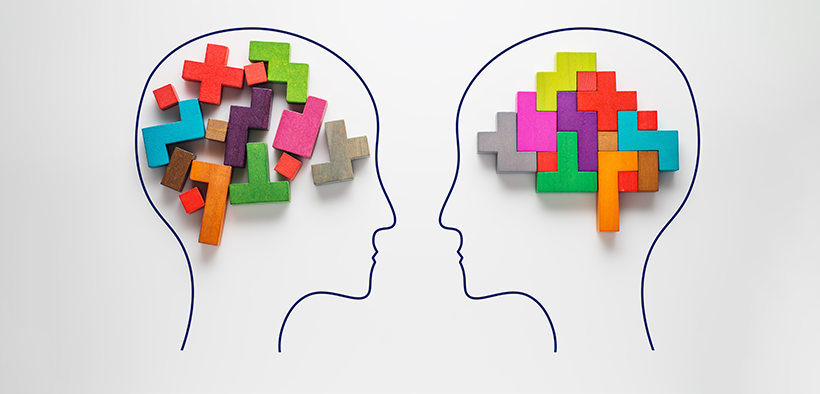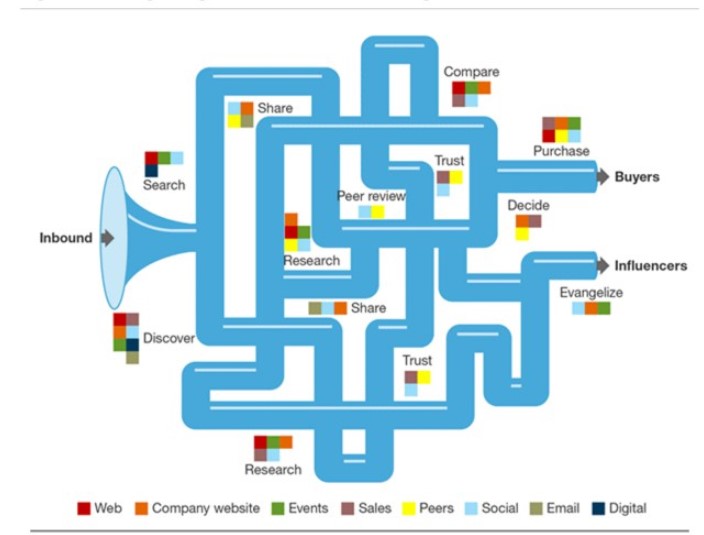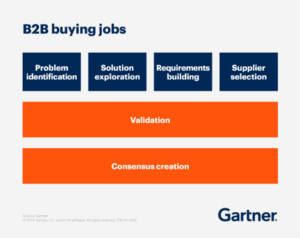Share

I’ve been reading some recent commentary comparing B2B (business-to-business) and B2C (business-to-consumer) marketing – the similarities, the differences and the size of the gap in between. It is good to discuss. The complexity of the B2B segment is growing, so now is the time to deep dive on its marketing.
It’s good to discuss as awareness and complexity of the B2B segment grows.
This article focuses on important gaps that require different thinking and strategy for B2B. It goes beyond ‘stating the obvious’ such as different market sizes and the fact that all buyers are humans.
If you’re a CMO, CRO or CEO of a B2B business, read on to understand what skills and experience you need in a high-performance B2B marketing team that is not found in your traditional B2C team.
Fuelling this debate is as important now as ever. B2B has become its own specialisation in marketing. CMOs are under more pressure to have a measurable impact on growth, and in order to rise to the top, they need a deep understanding of the business buying process and strong alliance with the sales organisation.
The five pillars of B2B and B2C marketing differentiation
The hybrid firms doing both B2B and B2C are the best placed to see the need for specialisation. They do not ask their B2B team to run B2C and visa-versa.
Here’s five key factors driving this evolution.
Difference #1: the buying journey
Firstly, the average duration of the buying B2B process is long. We often quote it being three months to three years. B2C is typically a much shorter transactional process – from the daily spontaneity of FMCG to the more considered multiple-month purchase cycle in the auto sector. The B2B buyer rarely follows the breadcrumbs we may lay on the path to purchase. They usually start by researching online to find solutions to their business problem which requires the savvy marketer to have placed relevant content in the right places.
We know there are certain phases B2Bers pass through:
- Awareness – growing their understanding of the problem, the macro and industry trends, the benefits of solving the problem, how others has addressed the task.
- Consideration – unpacking the solution options which will include outsourcing, insourcing, hybrid models or even ‘doing nothing’. During this stage they will formulate a view around a preference and build out their business case.
- Decision – engaging the preferred vendor/s (if they have not already), delving into the details, refining the business case, getting references, negotiating the deal.
We do not rely on the buyer going through the stages, content and channels in a sequential process. It’s more a simultaneous backward-and-forward motion that might look like
a bowl of spaghetti.

Way back in 2012, Lori Wizdo from Forrester changed what the process and channels looked like.

The fact that the B2B journey is more complex than B2C is not new. Marketers need to run a 24×7 always-on program that provides insights and content that the buyer can self-serve at their convenience – not when the seller wants or expects that consumption to happen. And, by the way, the buyer will decide what channel and device that will be on, which also is variable.
Difference #2: the buying party
What is the buying party? It is a group of decision makers, recommenders, influences and users who are involved in the decision to buy – as well as external advisors and influencers.
In B2C, the ‘buying party’ is generally one. The consumer decides what shoes, mobile phone, book or, for that matter, brand of spaghetti they will buy – solo.
In a business, the buying party can vary from as little as three or as much as 30, if not more. The size is often a function of the investment – the bigger the investment, the more people involved. Our research (‘Dark Funnel’ online seminar survey March 2022) found that more than half of B2B marketers have between six to ten people in the buying party.
Gartner quotes the same six to ten people on average in the buying party and that each of these people are armed with several information assets.
Gartner also refers to six core B2B buying jobs that align to the three stages mentioned above. As marketers, we need to consider which buying party members are involved in which jobs and what information they need at that stage. For example, we don’t want to serve up technical information to a CFO, nor want to send macro market insights to a buying party at the decision stage.

B2C marketers have to address the buying journey of one consumer, usually with a focus on brand awareness with a single proposition followed by buy-now sales activation offers. B2B marketers have to address taking many buyers on a mid-long term journey with multiple personalised messages and content for many stages (jobs). They have to keep the virtual engagement alive and their brand front-of-mind for months/years until the buyer is ready to engage with the selling organisation.
Difference #3: the investment
The next significant B2B/B2C difference is the investment involved. It’s true that there can be high investment scenarios in B2C such as house/property, education and luxury vehicles. These are ‘considered purchases’ that can mirror the B2B journey in terms of time but not complexity of decision making.
B2B buying complexity grows in correlation to investment value which we see broadly across the $10,000 to $1,000,000 range. For larger investments, we generally stop talking about products and services and start talking about the marketing of ‘solutions’ to business problems which need a different mindset to B2C messaging.
As with B2C, B2B is interested in the customer lifetime value. However calculating this is more complex in B2B.
B2Bers don’t have access to the vast lakes of data B2Cers have and hence have more difficulty in determining the likelihood of the next B2B purchase which in turn impacts calculation of CLV. And we want to understand CLV (or Annual Recurring Revenue for services related deals) so as to appropriate marketing spend. We of course want to invest more budget and effort in areas where we will get more return.
Difference #4: sales and marketing alignment
Herein lies the perennial opportunity space in B2B – ALIGNMENT. I don’t want to call it a problem as I prefer to take a positive stance. It’s a growth opportunity.
B2B marketers generally do not collaborate well with the sales counterparts. Only 52 percent have a strategic relationship according to the Green Hat/BBN/AMI B2B Outlook Research report. In fact I think that is overstated when one unpacks the tactical activity.
Alignment of what I hear you asking?
- shared Goals – without sharing goals, silos can form;
- language – same definitions for Ideal Customer Profile, Target Account List, Marketing Qualified Account/Lead;
- process – sales and marketing working together on lead management through the stages versus throwing Marketing Qualified Leads (MQLs) over the fence to sales and hoping to convert Sales Qualified Leads (opportunities);
- systems – integrated CRM to marketing automation/website platforms for streamlined data flow; and
- customer/market insights – the collaboration ‘war’ room to share insights to drive targeting, messaging, content.
A B2C marketer would need to have a significant mind-shift to be able to fill the B2B sales and marketing alignment void – a challenge most B2B marketers still have not solved!
And let’s remember that B2B firms are primarily sales’ led, not marketing-led like B2C firms (with some exceptions like auto/property). The B2B sales leader has the louder voice and influence with the CEO/CFO which means the B2B CMO needs to be on top of this alignment opportunity and lead the firm through to the promised land.
The take-away: alignment is a tough ask for a B2C marketer with a limited understanding of the needs of B2B Sales and how to align marketing to meet those.
This is all without even touching on alignment for Account-Based Marketing (ABM) – an account-centric approach to B2B that is the strategy-du-jour and fast becoming the way B2B work will be done in the future. If you want to understand more about ABM, check out the BBN podcast here.
Difference #5: rational versus emotional connection
Finally there is ‘connection’ or, more often in B2B, what marketers call ‘engagement’.
B2B decisions are more weighted to rational analysis than emotional connection. We know the buyers are ‘humans’ (please don’t tell me again) and so the buyer feels emotion with everything they do.
In B2B, the message, creative and content needs to address business problems and challenges. The deeper insight the marketer has of the ‘rational factors’, the better chance of making a sustainable connection with the buying party of the business.
Examples of these rational factors in B2B are ROI, functional fit, differentiation and proof of performance. They often lead to a binary response. It does or it doesn’t. Does this solution meet our internal investment benchmark? Does it have feature X or function Y? Can they provide evidence that validates their claim?
Don’t get me wrong here. B2Bers do want to find ways to emotionally connect and can see the value in doing so. The buyer’s personal value is a key territory for messaging. The B2B buyer thinks and feels the following:
- Is this brand I am intending to propose known? And if so, is it respected by the people internally and advisors that matter?
- Do I trust the seller (their people and their capability) to deliver?
- How will this decision impact my reputation in the firm?
- How will it impact my future promotional opportunities (and remuneration)?
- Can I work with this seller – especially relevant in long-term solution selling? Is the chemistry right as this seller relationship could be for the long haul?
Whereas the B2C marketer will spend more time thinking about how they can get the consumer to love their brand, the B2B marketer today spends more time making rational connections, with consideration here to the length of the buying cycle and size of investment covered earlier. Rightly or wrongly.
The times they are a’changing
“Come gather round people wherever you roam, And admit that the waters around you have grown,” Bob Dylan.
Cannes Lions acknowledge the times are a’changing – it has now launched the Creative B2B Lion and an evolved Creative Commerce Lion to recognise great B2B work.
We recognise that ‘Marketing is still Marketing’. The 4 Ps (or however many Ps in your pod!) remain the same in theory. Both marketing genres come from the same school of marketing and thankfully are learning from each other. For example, B2B is learning about the art of emotional connection with the buyer and B2C is learning about direct-to-consumer journey mapping and longer term engagement for considered purchases.
But there is no doubt the times a’changing for B2B marketers, Performance expectations continue to rise. The B2B CEO wants more measurable impact from his marketing team. Today, most aspects of marketing contribution are trackable with data-driven martech and advances in AI and machine learning. Further, the buyer has changed the way they buy and thus become invisible for much of their long journey.
As you can read in Green Hat’s annual B2B Outlook Research Report, best-in-class B2B marketers are honing their skills to better understand the spaghetti B2B journey, the buying party and personas, account targeting and sales alignment – all specialist skills unique to the B2B universe.
Andrew Haussegger is co-founder and CEO of Green Hat, born in 2001 and grown up to be Australia’s largest B2B agency.















